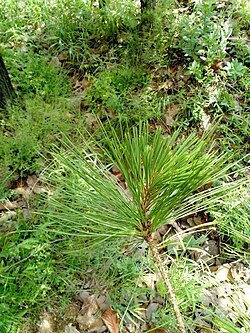Biology:Pinus georginae
| Pinus georginae | |
|---|---|

| |
| A branch of an individual | |
| Scientific classification | |
| Kingdom: | Plantae |
| Clade: | Tracheophytes |
| Clade: | Gymnospermae |
| Division: | Pinophyta |
| Class: | Pinopsida |
| Order: | Pinales |
| Family: | Pinaceae |
| Genus: | Pinus |
| Subgenus: | P. subg. Pinus |
| Section: | P. sect. Trifoliae |
| Subsection: | P. subsect. Australes |
| Species: | P. georginae
|
| Binomial name | |
| Pinus georginae Pérez de la Rosa (2009)[1]
| |
Pinus georginae, commonly known (in Spanish) as Pino chino, is a species of medium-sized conifer in the family Pinaceae. It was first described by Pérez de la Rosa in 2009, and was named for Georgina Vargas Amado, who was with Pérez de la Rosa at the time of the tree's description. It is in the Pinus subsect. Australes.[1]
Description
Pinus georginae on average reaches 15-20 m (49-66 feet) tall, and 30-35 cm (12-14 inches) in diameter, with a generally rounded crown. Bark is in pale to dark grey rectangular plates, with twigs at 4-6 mm (0.16-0.24 inches) thick. Leaves (Needles) are in fascicles of 3-5, being 15-17 mm (0.59-0.67 inches) long. Cones are curved, being 16-20 mm (0.63-0.79 inches) long, and 4-5 mm (0.16-0.20 inches) wide. Curved cones fall with part of the branchlet still attached. Bark flakes easily, and the wood is quite delicate. Pollination occurs in June and July; cone maturation takes up to two years. Seed dispersal is throughout March and April. Seeds are 6.5-7.3 mm (0.25-0.29 inches) long, and germinate after some of the first rains in June. Crooked trunk with a low-lying, thick top, which is very similar to Pinus praetermissa (a closely related species).[1]
Distribution and ecology
Pinus georginae is found throughout parts of west-central Jalisco, Mexico, at the convergence of the Sierra Madre Occidental, Trans-Mexican Volcanic Belt, Sierra Madre del Sur, and the Mexican Altiplano (Mexican Plateau).[2]
It grows exclusively in the Subtropical Biome, which is the same for most other species of Mexican-endemic pines.[3]
Primarily, the species is known to grow throughout the towns of Atenguillo, Cuautla, and Mascota, at elevations of 1400-1700 m (4593-5577 feet) in intermountain valleys, specifically south of the Rio Ameca river basin, with scattered individuals and some spread out stands.[1]
The general area where Pinus georginae's range resides in Jalisco, averages 932 mm (36.69 inches) of rain every year, with dry-temperate seasons of 70°F (21.6°C).[1]
The species population occurs in pine-oak forests found near and within close proximities of natural grasslands. It is found growing with other species of pine, such as Pinus douglasiana, Pinus devoniana, Pinus oocarpa, Pinus lumholtzii, and Pinus luzmarie.[2]
It is also seen growing beside two species of oak (Quercus spp.), Quercus resinosa and Quercus obtusata.[1]
Pinus georginae, besides Pinus praetermissa, is most closely related to Pinus luzmarie, a sympatric pine species that likely diverged from Pinus georginae during the Early Pleistocene Period.[1]
The species is often parasitized by Cladocolea cupulata (a species of parasitic mistletoe).[1]
Classification and conservation
Pinus georginae was originally assigned under Pinus praetermissa (which it closely resembles), but was later assigned to a new taxon, as basic molecular analysis experiments properly showed that Pinus georginae is its own endemic species.[2]
No conservation status has been established for Pinus georginae yet, and is currently listed as "Not Evaluated" by many sources, although deforestation and wildfires may be common threats to its range.[4]
Uses
Lumber from Pinus georginae is of a low quality, and can easily break because of the species' low trunk, hence lumber production is very limited. The species is extremely resinous though, producing large amounts of resin, which is harvested by locals in small quantities and sold at local markets. Brush from the tree could be used as a fire starter, but that generally isn't likely because of the species rarity and scarceness throughout the region and its range.[2]
References
- ↑ 1.0 1.1 1.2 1.3 1.4 1.5 1.6 1.7 "Pinus georginae description - The Gymnosperm Database". https://www.conifers.org/pi/Pinus_georginae.php.
- ↑ 2.0 2.1 2.2 2.3 Pérez de la Rosa, Jorge Alberto (March 2, 2009). "Pinus georginae (Pinaceae), a New Species from Western Jalisco, Mexico". Brittonia 61 (1): 56–61. doi:10.1007/s12228-008-9061-9. https://www.jstor.org/stable/30218818.
- ↑ "Pinus georginae Pérez de la Rosa | Plants of the World Online | Kew Science" (in en). http://powo.science.kew.org/taxon/urn:lsid:ipni.org:names:77101164-1.
- ↑ "Pinus georginae" (in en). https://www.inaturalist.org/taxa/633468-Pinus-georginae.
Wikidata ☰ Q17274580 entry
 |

